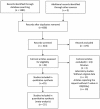Relation of Chlamydia trachomatis infections to ectopic pregnancy: A meta-analysis and systematic review
- PMID: 31895782
- PMCID: PMC6946389
- DOI: 10.1097/MD.0000000000018489
Relation of Chlamydia trachomatis infections to ectopic pregnancy: A meta-analysis and systematic review
Abstract
Background: In a multitude of previous studies, Chlamydia trachomatis (CT) plays an important role in the occurrence of ectopic pregnancy (EP). However, the predictive value of CT infections in the occurrence of EP has not been estimated worldwide. We thus evaluated, by means of a meta-analysis, the current status of the association between CT infections with EP and the potential predictive value of CT infections in EP.
Methods: We evaluated studies performed between the database construction time and August 2018 published in PubMed, the Cochrane Library, EMBASE, and the Web of Science (SCI). The relationship between CT and EP was calculated based upon the predetermined entry criteria for control group selection and the original data. The related articles were analyzed using a random-effects model, and the heterogeneity of the studies was assessed using the I index. Data were analyzed with the STATA 12.0 software.
Results: Twenty-five studies that recruited 11960 patients were included in the present meta-analysis, and the relation of CT infections with EP were assessed. The association between CT infections and EP risk showed an odds ratio (OR) of 3.03, with a 95% confidence interval (CI) of 2.37 to 3.89. Our results showed that there was a statistically significant difference between the intervention and control groups. The prevalence of CT infections in EP was then calculated by a subgroup analysis: African (OR, 2.22; 95% CI, 1.14-4.31), European (OR, 3.16; 95% CI, 2.10-4.47), North American (OR, 3.07; 95% CI, 1.78-5.31), and Asian (OR, 3.39; 95% CI, 1.95-5.90).
Conclusions: From the results of numerous studies conducted on different continents, this meta-analysis showed a clear association between EP and prior CT infections, that is, CT infections increase the risk of EP occurrence.
Conflict of interest statement
The authors state that they have no conflicts of interest.
Figures





References
-
- Goller JL, De Livera AM, Guy RJ, et al. Rates of pelvic inflammatory disease and ectopic pregnancy in Australia, 2009-2014: ecological analysis of hospital data. Sex Transm Infect 2018;94:534–41. - PubMed
-
- Millman K, Black CM, Stamm WE, et al. Population-based genetic epidemiologic analysis of Chlamydia trachomatis serotypes and lack of association between ompA polymorphisms and clinical phenotypes. Microbes Infect 2006;8:604–11. - PubMed
-
- Sciarra JJ. Sexually transmitted diseases: global importance. Int J Gynaecol Obstet 1997;58:107–19. - PubMed
-
- Lehr S, Vier J, Hacker G, et al. Activation of neutrophils by Chlamydia trachomatis-infected epithelial cells is modulated by the chlamydial plasmid. Microbes Infect 2018;20:284–92. - PubMed

